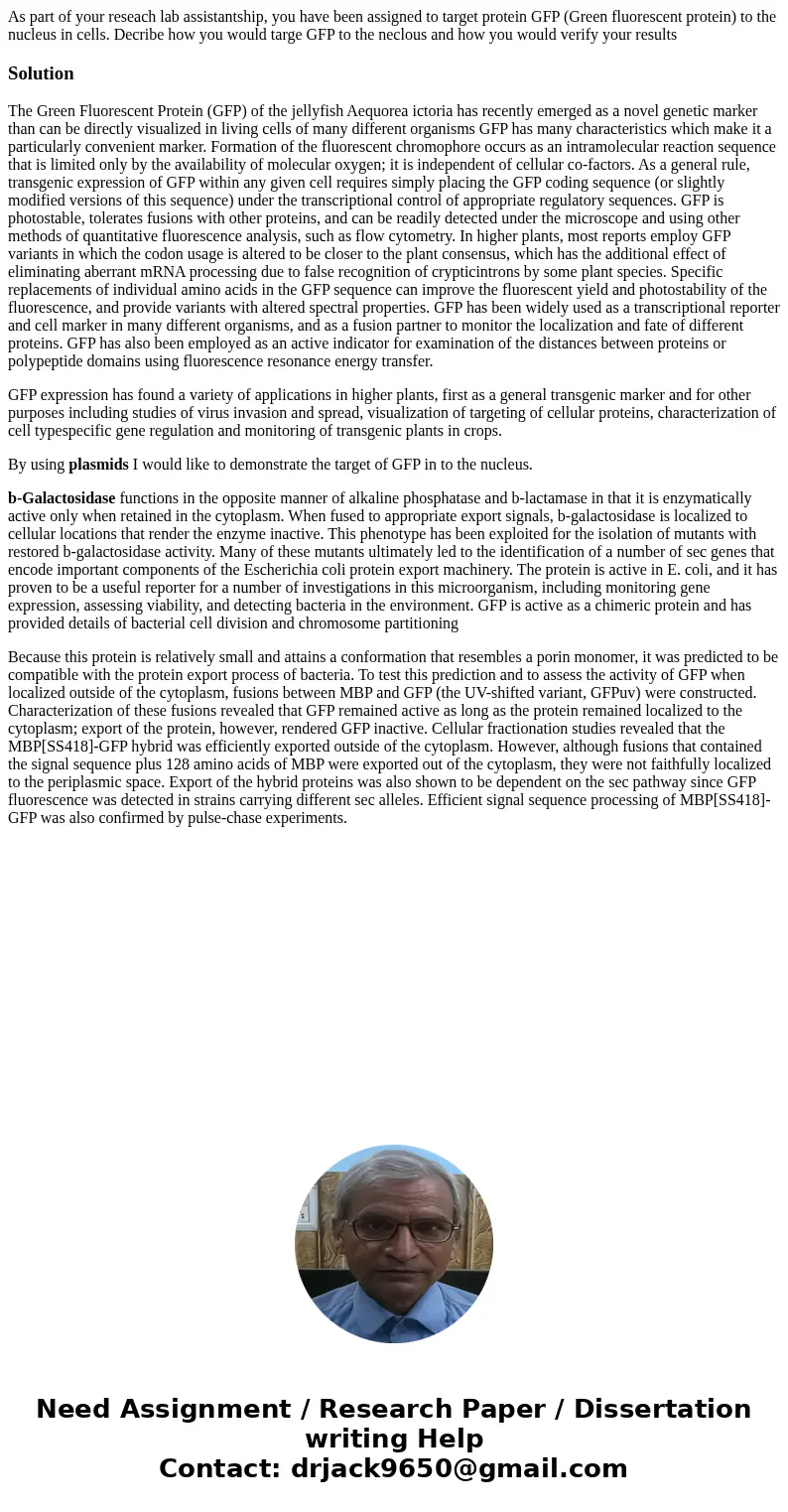As part of your reseach lab assistantship you have been assi
As part of your reseach lab assistantship, you have been assigned to target protein GFP (Green fluorescent protein) to the nucleus in cells. Decribe how you would targe GFP to the neclous and how you would verify your results
Solution
The Green Fluorescent Protein (GFP) of the jellyfish Aequorea ictoria has recently emerged as a novel genetic marker than can be directly visualized in living cells of many different organisms GFP has many characteristics which make it a particularly convenient marker. Formation of the fluorescent chromophore occurs as an intramolecular reaction sequence that is limited only by the availability of molecular oxygen; it is independent of cellular co-factors. As a general rule, transgenic expression of GFP within any given cell requires simply placing the GFP coding sequence (or slightly modified versions of this sequence) under the transcriptional control of appropriate regulatory sequences. GFP is photostable, tolerates fusions with other proteins, and can be readily detected under the microscope and using other methods of quantitative fluorescence analysis, such as flow cytometry. In higher plants, most reports employ GFP variants in which the codon usage is altered to be closer to the plant consensus, which has the additional effect of eliminating aberrant mRNA processing due to false recognition of crypticintrons by some plant species. Specific replacements of individual amino acids in the GFP sequence can improve the fluorescent yield and photostability of the fluorescence, and provide variants with altered spectral properties. GFP has been widely used as a transcriptional reporter and cell marker in many different organisms, and as a fusion partner to monitor the localization and fate of different proteins. GFP has also been employed as an active indicator for examination of the distances between proteins or polypeptide domains using fluorescence resonance energy transfer.
GFP expression has found a variety of applications in higher plants, first as a general transgenic marker and for other purposes including studies of virus invasion and spread, visualization of targeting of cellular proteins, characterization of cell typespecific gene regulation and monitoring of transgenic plants in crops.
By using plasmids I would like to demonstrate the target of GFP in to the nucleus.
b-Galactosidase functions in the opposite manner of alkaline phosphatase and b-lactamase in that it is enzymatically active only when retained in the cytoplasm. When fused to appropriate export signals, b-galactosidase is localized to cellular locations that render the enzyme inactive. This phenotype has been exploited for the isolation of mutants with restored b-galactosidase activity. Many of these mutants ultimately led to the identification of a number of sec genes that encode important components of the Escherichia coli protein export machinery. The protein is active in E. coli, and it has proven to be a useful reporter for a number of investigations in this microorganism, including monitoring gene expression, assessing viability, and detecting bacteria in the environment. GFP is active as a chimeric protein and has provided details of bacterial cell division and chromosome partitioning
Because this protein is relatively small and attains a conformation that resembles a porin monomer, it was predicted to be compatible with the protein export process of bacteria. To test this prediction and to assess the activity of GFP when localized outside of the cytoplasm, fusions between MBP and GFP (the UV-shifted variant, GFPuv) were constructed. Characterization of these fusions revealed that GFP remained active as long as the protein remained localized to the cytoplasm; export of the protein, however, rendered GFP inactive. Cellular fractionation studies revealed that the MBP[SS418]-GFP hybrid was efficiently exported outside of the cytoplasm. However, although fusions that contained the signal sequence plus 128 amino acids of MBP were exported out of the cytoplasm, they were not faithfully localized to the periplasmic space. Export of the hybrid proteins was also shown to be dependent on the sec pathway since GFP fluorescence was detected in strains carrying different sec alleles. Efficient signal sequence processing of MBP[SS418]-GFP was also confirmed by pulse-chase experiments.

 Homework Sourse
Homework Sourse